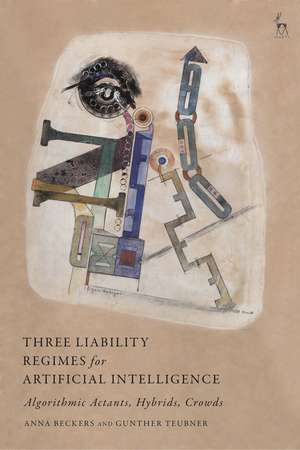Three Liability Regimes for Artificial Intelligence: Algorithmic Actants, Hybrids, Crowds
Autor Anna Beckers, Gunther Teubneren Limba Engleză Paperback – 14 iun 2023
| Toate formatele și edițiile | Preț | Express |
|---|---|---|
| Paperback (1) | 303.51 lei 6-8 săpt. | |
| Bloomsbury Publishing – 14 iun 2023 | 303.51 lei 6-8 săpt. | |
| Hardback (1) | 538.92 lei 6-8 săpt. | |
| Bloomsbury Publishing – 26 ian 2022 | 538.92 lei 6-8 săpt. |
Preț: 303.51 lei
Preț vechi: 372.79 lei
-19% Nou
Puncte Express: 455
Preț estimativ în valută:
58.08€ • 60.64$ • 48.07£
58.08€ • 60.64$ • 48.07£
Carte tipărită la comandă
Livrare economică 04-18 aprilie
Preluare comenzi: 021 569.72.76
Specificații
ISBN-13: 9781509949373
ISBN-10: 1509949372
Pagini: 240
Dimensiuni: 156 x 234 x 25 mm
Greutate: 0.29 kg
Editura: Bloomsbury Publishing
Colecția Hart Publishing
Locul publicării:London, United Kingdom
ISBN-10: 1509949372
Pagini: 240
Dimensiuni: 156 x 234 x 25 mm
Greutate: 0.29 kg
Editura: Bloomsbury Publishing
Colecția Hart Publishing
Locul publicării:London, United Kingdom
Caracteristici
Relies on a unique combination of information technology studies, sociological studies, risk analysis, and comparative law
Notă biografică
Anna Beckers is Assistant Professor of Private Law and Legal Methodology at the Faculty of Law, Maastricht University, the Netherlands. Gunther Teubner is Professor Emeritus of Private Law and Legal Sociology at the Faculty of Law, Goethe-University Frankfurt am Main, Germany.
Cuprins
1. Digitalisation: The Responsibility Gap I. The Problem: The Dangerous Homo Ex Machina A. Growing Liability Gaps B. Scenarios C. Current Law's Denial of Reality II. The Overshooting Reaction: Full Legal Subjectivity for E-Persons? III. Our Solution: Differential Legal Status Ascriptions for Algorithms A. Algorithms in Social and Economic Contexts B. (Legal) Form Follows (Social) FunctionIV. Our Approach: Three Digital Risks A. 'Socio-Digital Institutions' as Intermediaries between Technology and Law B. A Typology of Machine Behaviour C. A Typology of Socio-Digital Institutions D. A Typology of Liability Risks 2. Autonomy and Personification I. Artificial Intelligence as Actants A. Anthropomorphism? B. Actants and Action Attribution C. Communication with Actants II. Gradualised Digital Autonomy A. Social Attribution of Autonomy B. Legal Criteria of Autonomy C. Our Solution: Decision under Uncertainty III. Autonomy and Legal Personhood A. Against Personification? B. Uniform Personification? C. Socio-Digital Institutions and Legal Status 3. Actants: Autonomy Risk I. Socio-Digital Institution: Digital Assistance II. The Autonomy Risk III. Algorithmic Contract Formation A. Invalidity of Algorithmic Contracts? B. Algorithms as Mere Tools? C. Our Solution: Agency Law for Electronic Agents D. Limited Legal Personhood - Constellation One E. The Digital Agent's Legal DeclarationF. Digital Assistance and the Principal-Agent Relation G. Overstepping of Authority? IV. Contractual Liability A. The Dilemma of the Tool-Solution B. Our Solution: Vicarious Performance C. Limited Legal Personhood - Constellation Two V. Non-Contractual Liability A. Fault-Based Liability? B. Product Liability? C. Strict Causal Liability for Dangerous Objects and Activities? D. Our Solution: Vicarious Liability in Tort E. Limited Legal Personhood - Constellation Three F. The 'Reasonable Algorithm' G. Who is Liable? 4. Hybrids: Association Risk I. Socio-Digital Institution: Human-Machine AssociationsA. Emergent Properties B. Hybridity C. The Organisational Analogy II. The Association Risk III. Solution de lege ferenda: Hybrids as Legal Entities? IV. Our Solution de lege lata: Enterprise Liability for Human-Machine Networks A. Human-Machine Interactions as Networks B. Networks and Enterprise Liability 1C. Action Attribution and Liability Attribution in Hybrids D. Liable Actors E. Pro-Rata Network Share Liability F. External Liability Concentration: 'One-Stop-Shop' Approach G. Internal Liability Distribution: Pro Rata Network Share V. Conclusion 5. Multi-Agent Crowds: Interconnectivity Risk I. Socio-Digital Institution: Exposure to Interconnectivity A. Non-Communicative Contacts B. Distributed Cognitive Processes II. The Interconnectivity Risk III. Mismatch of New Risks and Existing Solutions A. Applying Existing Categories B. Vicarious or Product Liability of the Whole Interconnected AI-System? C. Collective Liability of Actors Connected to the 'Technical Unit'? IV. Our Solution: Socialising the Interconnectivity Risk A. Entire or Partial Socialisation? B. Risk Pools Decreed by Law C. Public Administration of the Risk Pool: The Fund Solution D. Financing: Ex-Ante and Ex-Post Components E. Participation and Administration F. Compensation and Recovery Action G. Global Interconnectivity and National Administration 6. Conclusion: Three Liability Regimes and Their Interrelations I. Synopsis and Rules A. Digital Assistance: Vicarious Liability B. Human-Machine Associations: Enterprise Liability C. Interconnectivity: Fund Liability II. Socio-Digital Institutions and Liability Law A. One-Size-Fits-All or Sector-Specific Piecemeal Approach? B. Socio-Digital Institutions C. Institution-Generating Liability Law D. Differential Treatment of Liable Actors E. Calibrating Legal Personhood for AI III. Interactions between Three Liability Regimes A. Criteria for Delineating the Applicable Liability Regime B. No Priority for a Liability Regime IV. Exemplary Cases A. Vicarious Liability: Robo-Advice B. Enterprise Liability: Hybrid Journalism C. Collective Funds: Flash Crash D. Finale: Google Autocomplete
